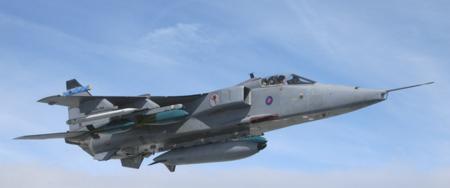Jaguar
Single-seat attack and reconnaissance aircraft Two-seat trainer
Upgraded to use GPS navigation and helmet-mounted missile sight
Details:
Produced to meet a joint Anglo-French requirement in 1965 for a dual-role
advanced/operational trainer and tactical support aircraft, the Jaguar
has been transformed into a potent fighter-bomber. Deliveries began
in 1973, and at its peak the Jaguar equipped 8 front-line RAF squadrons
in the UK and Germany.
The RAF's Jaguar fleet has recently undergone a major upgrade programme
and been designated as the Jaguar GR3 (or T4 for the 2-seat version).
The upgrade included improved avionics including Global Positioning
System (GPS) and Terrain-Referenced Navigation (TRN) , Night Vision
Goggles (NVG) compatible lighting (both internally and externally),
helmet-mounted sight and ASRAAM capability, and new Head-Up and Head-Down
Displays in the cockpit.
Jaguar Specifications
Engines:
Two Turbomeca/Rolls-Royce Adour turbofans
Length:
55ft 2in (16.83m)
Wingspan:
28ft 6 in (8.69m)
Top Speed:
1,056mph (1,700km/h)
Accommodation:
GR3: pilot only;
T4: pilot and pupil in tandem
The Jaguar is capable of using 1,000lb general purpose bombs, Paveway
laser- and GPS-guided bombs, rocket pods and its Aden cannon. For self-defence
a pair of Sidewinder or ASRAAM air-to-air missiles air-to-air missiles
can be mounted on the over-wing hardpoints. It can be fitted with an
external fuel tank on the centreline pylon, or 2 tanks under the wings.
In the reconnaissance role the Jaguar is fitted with an externally mounted
pod, equipped with conventional 'wet film' and sensors. It can also
carry the Thermal Imaging Airborne Laser Designator (TIALD) pod for
self-designation or co-operative designation of precision-guided weapons.
Roles
Air Interdiction (AI). Low- or medium-level attacks using precision-guided,
freefall or retarded bombs.
Close Air Support (CAS). Air action against hostile targets that are
in close proximity to friendly forces on the ground.
Tactical Reconnaissance (Tac Recce).
Armament
Two 30mm Aden guns and up to 10,000lb (4,500kg) of stores. Weapons available
include 1,000lb general purpose bombs, CBU-87 cluster bombs, Paveway
2 and 3 precision-guided bombs and CRV-7 rocket pods. Two Sidewinder
or ASRAAM air-to-air missiles (carried over-wing) are used for self-defence.
When used in the reconnaissance role, the Joint Reconnaissance Pod is
carried under the fuselage on the centreline pylon.
Recognition
Long sleek fuselage with a large swept tail fin and rudder. Relatively
short-span swept wings are shoulder-mounted on the fuselage. The internal
jet engines have intakes either side of the fuselage behind the cockpit,
with their top surfaces forming an extension of the wing. The rear jetpipes
are located forward and below the tailplane (1) which has marked anhedral
(downward slope). The raised bubble canopy is set above the sharply-pointed
'chisel' nose (2). The twin mainwheels of the undercarriage retract
into the fuselage (3). Two-seater aircraft have no radar and, as a consequence
of accommodating the second pilot, a much larger canopy and small, pointed
nose (4).
|



